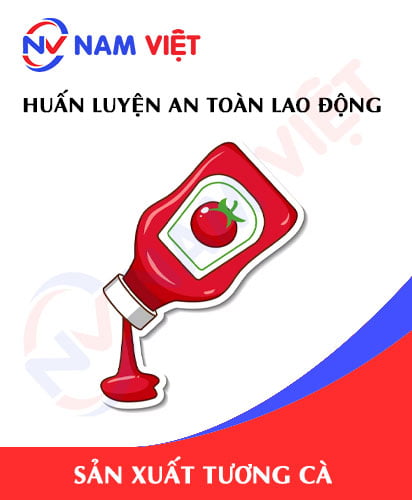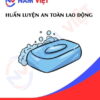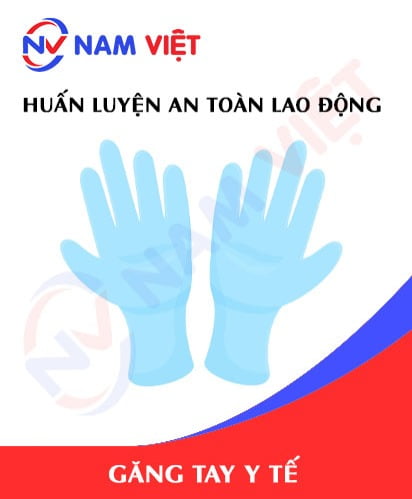Occupational Safety Training in Ketchup Manufacturing Factory
99,000 ₫
Note: The above price is calculated for one person and may fluctuate depending on the number of trainees participating in the course and market movements. For more accurate pricing support, please refer to the quotation table or contact our consulting staff directly.
Occupational safety is an important issue in factories manufacturing ketchup and needs to be addressed promptly to ensure the health and safety of workers and enhance the reputation of businesses. The Occupational Safety Training course is an effective solution to raise awareness among workers about accident prevention when participating in ketchup manufacturing.
Table of Contents
Toggle1. Overview of Ketchup
a. What is Ketchup?
- Ketchup is a sauce made from pureed tomatoes and mixed with spices such as salt, sugar, garlic, onion, chili, herbs and other flavor enhancers to create a delicious and nutritious mixture. Ketchup is often used as a condiment or a sauce to accompany dishes such as pizza, sausages, french fries and many other foods.
- According to a report by the Ministry of Industry and Trade, Vietnam’s ketchup output has grown strongly from about 96,000 tons in 2015 to about 182,000 tons in 2019. The main ketchup manufacturing provinces in Vietnam include Ha Noi, Hai Duong, Hai Phong, Ninh Binh, Thai Binh, Hung Yen and Bac Ninh.
- It is noteworthy that Vietnamese ketchup manufacturers are gradually shifting to using more modern and advanced manufacturing technology. Many large ketchup factories have invested in modern equipment and machinery to improve the manufacturing process and increase productivity.
- In addition, Vietnamese ketchup has also been exported to many international markets such as the US, Canada, Japan, Korea, Taiwan, China, Cambodia, Laos, etc. The export output of Vietnamese ketchup has grown significantly, creating many business opportunities for ketchup manufacturers in Vietnam.

b. Types of machinery for ketchup manufacturing
The types of machinery for ketchup manufacturing often include:
- Tomato washing machine: This machine is used to wash tomatoes clean before they are pureed.
- Tomato cutting machine: This machine is used to cut tomatoes into small pieces before grinding.
- Tomato grinder: This machine is used to puree tomatoes after they have been washed and cut into small pieces.
- Ketchup pressing machine: This machine is used to press ketchup from the pureed tomato mixture.
- Ketchup mixer: This machine is used to mix the ketchup evenly after pressing to create a uniform and quality product.
- Bottling/bagging machine: This machine is used to package the ketchup product into bottles or bags for convenient transportation and use.

c. Typical ketchup manufacturing enterprises
Currently in Vietnam there are many ketchup manufacturing enterprises with different scales and product quality. Here are some typical ketchup manufacturing enterprises:
- Ngon Ketchup Co., Ltd.: A large-scale ketchup manufacturing enterprise whose products are highly appreciated for quality. The company is headquartered in Ho Chi Minh City.
- Ha Noi Group Joint Stock Company: A famous ketchup manufacturing enterprise in the North. The company’s products are manufactured on a modern technology line and meet high-quality standards.
- Masan Group Joint Stock Company: A leading multi-industry economic group in Vietnam, with high-quality ketchup products that meet international quality standards. The company is headquartered in Ho Chi Minh City.
- Chi Hoa Food Co., Ltd.: A traditional ketchup manufacturing enterprise in the West. The company’s products are made from natural ingredients and meet food hygiene and safety standards.
- Trung An Food Co., Ltd.: An enterprise with long experience in the field of ketchup manufacturing. The company’s products are made from fresh ingredients and ensure food hygiene and safety. The company is headquartered in Can Tho City.
d. Specific jobs in a ketchup manufacturing factory
Group 1
- Executive director, deputy executive director, department head in a ketchup manufacturing factory.
Group 2
- Safety officer: manages safety in the factory, designs safety procedures, supervises and urges employees to comply with safe working procedures.
Group 3
- Preparing ingredients: The necessary ingredients to manufacture ketchup include tomatoes, salt, sugar, spices and acid regulators. Workers must arrange, select and cut these ingredients into small pieces for use.
- Processing: After all the ingredients have been prepared, workers must process them to manufacture ketchup. The ingredients are put into a grinder, where they are pureed and mixed evenly with spices and acid regulators.
- Cooking: After being mixed evenly, the mixture is cooked in a steamer to convert it into ketchup. Workers must check and adjust the acidity, salt and sugar levels during the cooking process to ensure product quality.
- Packaging: After the product has been processed and cooked, it is packaged in bags or cans for preservation and consumption.
- Quality inspection: Each batch of products is checked for quality before being distributed. Workers must check the pH, turbidity, color, taste and smell of the ketchup to ensure that the product meets the set quality standards.
Group 4
- Jobs in the office, serving, sales, marketing.
- Manufacturing management, quality management, human resource management, material management, accounting and financial management.
- Research and development of new products, designing product packaging and labels.

2. Overview of the occupational safety training course in ketchup manufacturing
In the scope of this article, we focus on issues surrounding group 3, because group 3 is the group that directly participates in the manufacturing process and bears the highest risk of labor accidents. Refer to other groups here
a. What is group 3 occupational safety training?
- Occupational safety training for group 3 are training sessions that equip workers with awareness of how to prevent labor accidents.
- The occupational safety training course will help workers recognize and prevent dangers, and limit the risks of labor accidents during work.
REGISTER FOR OCCUPATIONAL SAFETY TRAINING SERVICE
b. Training time
Initial safety training time
- The total training time is at least 24 hours, including the test time.
- 8 hours of theoretical study on the system of policies and laws on occupational safety and hygiene
- 8 hours of theoretical study on basic knowledge of occupational safety and hygiene
- 4 hours of theoretical study on specialized training content
- 2 hours of practical study on specialized training content
- 2 hours of theoretical test at the end of the training course
The safety training center will distribute the time into many training sessions depending on the time arrangement for employees. But usually, there will be 6 training sessions, the course will take place in 3 days, provided that the manufacturing business can arrange continuous study time.
Periodic safety training time
- Before the occupational safety card expires, if the worker wants to have it reissued, they must undergo a periodic occupational safety training course, with the periodic safety training time being at least 50% of the initial safety training time.
Explanation: the total periodic occupational safety training time is at least 12 hours, including the test time. After completing the periodic training course and passing the test, the worker will be reissued and have their occupational safety card renewed.
c. Content of the training course
| No. | TRAINING CONTENT | TRAINING TIME (HOURS) | |||
| Total | In which | ||||
| Theory | Practice | Test | |||
| I | System of policies and laws on occupational safety and hygiene | 8 | 8 | 0 | 0 |
| 1 | Overview of the system of legal documents on occupational safety and hygiene. | 6 | 6 | ||
| 2 | System of technical standards and regulations on occupational safety and hygiene. | 1 | 1 | ||
| 3 | Specific regulations of state management agencies on occupational safety and hygiene when building new, expanding or renovating works, facilities for manufacturing, using, preserving, storing and inspecting types of machinery, equipment, materials, and substances with strict requirements on occupational safety and hygiene. | 1 | 1 | ||
| II | Basic knowledge of occupational safety and hygiene | 8 | 8 | 0 | 0 |
| 1 | Basic knowledge of dangerous and harmful factors in the workplace. | 4 | 4 | ||
| 2 | Methods to improve working conditions. | 1 | 1 | ||
| 3 | Safety culture in manufacturing and business. | 1 | 1 | ||
| 4 | Rights and obligations of employers, employees; policies and regimes on occupational safety and hygiene for employees; functions and tasks of the occupational safety and hygiene network. | 1 | 1 | ||
| 5 | Occupational safety and hygiene regulations, occupational safety and hygiene signs and instructions and the use of safety equipment, personal protective equipment; professional skills, first aid for labor accidents, and prevention of occupational diseases. | 1 | 1 | ||
| III | Specialized training content | 6 | 4 | 2 | 0 |
| General knowledge about types of machinery, equipment, and substances that generate dangerous and harmful factors; analysis, assessment, management of occupational safety and hygiene risks, safe working procedures with machinery, equipment, and substances with strict requirements on occupational safety and hygiene. | 6 | 4 | 2 | ||
| IV | Test on occupational safety training content at the end of the training course | 2 | 2 | 0 | 0 |
| Total | 24 | 22 | 2 | ||
See more training content of the 6 groups
d. Occupational safety card
After completing the occupational safety training course and passing the test, the worker will be issued an occupational safety card (in practice, it is also called a Group 3 occupational safety certificate).
In which, the Group 3 safety card will clearly show information such as: full name, date of birth, specific job and working environment. At the same time, it also has the training time, red stamp and signature confirming the completion of the training course.
According to the regulations on issuing safety cards specified in Clause 2, Article 24 of Decree 44/2016/ND-CP, there are 2 cases:
- In the case that the employer and the employee have a labor contract with each other, the employer must sign, stamp and affix a seal on the safety card for the trained person in group 3 after undergoing the training course from the occupational safety training unit, and at the same time passing the test.
- In the case that the worker is a freelancer, seasonal worker, and does not have a labor contract, the training unit must sign, stamp and affix a seal on the safety card for the worker after undergoing the training course from the occupational safety training unit, and at the same time passing the test.

3. Identifying dangers when manufacturing ketchup
Some common dangers when manufacturing ketchup may include:
- Manufacturing employees can be injured when using manufacturing machinery, moving raw materials or loading finished products.
- Ketchup manufacturing often uses flammable materials such as oil, gas, chemicals… Therefore, the risk of fire and explosion in a ketchup manufacturing factory is very high.
- Chemicals used in the ketchup manufacturing process such as acetic acid, salt, sugar, flavors… can cause health problems if not used correctly.
- The ketchup manufacturing process needs to ensure food hygiene and safety. If hygiene standards are not followed, the ketchup can be contaminated with bacteria that are harmful to the health of consumers.
4. Labor accidents that often occur when manufacturing ketchup
During the ketchup manufacturing process, labor accidents often occur such as:
- Injuries from knives and scissors: Jobs related to cutting, chopping and peeling tomatoes require high precision and speed. If knives and scissors are not used safely, it can cause serious injury to workers.
- Fire and explosion: During the manufacturing process, flammable materials such as oil, gas, and electricity can cause fire and explosion. If not used correctly and necessary safety measures are not taken, fire and explosion accidents can occur.
- Chemical poisoning: Chemicals used in the ketchup manufacturing process can cause poisoning to workers if not used correctly.
- Improper posture: Jobs that require workers to work in uncomfortable and long-term postures, especially when they have to stand for a long time or sit in an unnatural position.
- Temperature: The ketchup manufacturing process often requires workers to work in a high-temperature environment. If preventive measures are not taken, it can cause health accidents.
- Mechanical entanglement: automatic ketchup manufacturing machines have dangerous moving parts, and accidentally touching these moving parts can cause dangerous accidents.

5. Safety measures when participating in ketchup manufacturing
Implementing safety measures is very important in the ketchup manufacturing process to protect the health and life of workers. Here are some safety measures that need to be implemented when participating in ketchup manufacturing:
- Workers need to wear full protective equipment such as helmets, masks, safety glasses, gloves, safety shoes, to protect their bodies from the effects of machinery, chemicals and other substances.
- Workers need to comply with safety regulations such as not smoking in the manufacturing area, not using food or drinks in the manufacturing area.
- Factories need to regularly check equipment to ensure they are always working well and do not cause dangers to workers.
- The types of materials used in the ketchup manufacturing process need to be checked and ensured to be safe for workers.
- Factories need to train and instruct workers on safety measures, working procedures and how to use equipment to ensure safety during the manufacturing process.
- Periodically organize work environment monitoring in factories and enterprises, collect and analyze harmful factors for workers, thereby adjusting to reduce the harmful level to prevent occupational diseases for them.
6. Benefits of occupational safety training in ketchup manufacturing
An Toan Nam Viet provides businesses with great benefits after completing occupational safety training courses according to the regulations in Decree 44/2016/ND – CP on occupational safety and hygiene, companies, factories, businesses.
- Workers can identify the potential risks of labor accidents, thereby having preventive measures to avoid labor accidents.
- Businesses can establish risk prevention measures in the production, operation and maintenance process.
- Minimizing costs when there is a risk of occupational safety loss.
- Uninterrupted production process will help increase labor productivity and product quality.
- Complying with the correct regulations on labor safety law, avoiding legal risks.
- Creating prestige and professionalism in all aspects, thereby enhancing the brand for your business.
An Toan Nam Viet’s training courses are the solution to prevent and combat external factors affecting each individual so that they can avoid dangers that can lead to injury or, more seriously, death.
REGISTER FOR OCCUPATIONAL SAFETY TRAINING SERVICE
7. Customer feedback after completing the occupational safety training course in ketchup manufacturing
An Toan Nam Viet has many years of experience in the mission of accompanying many businesses in Vietnam in general and in the southern provinces in particular. And that responsibility is something very precious to An Toan Nam Viet, which is why An Toan Nam Viet’s Occupational Safety Training work is increasingly focused on being professional. And the motivation for An Toan Nam Viet to grow strongly to the present comes from the positive feedback and suggestions from businesses. Below are the feedbacks from our partners that we have served.
Bac Nam E&C Investment Construction Joint Stock Company
“The first time I used the service at An Toan Nam Viet, I was very surprised by the enthusiastic 24/7 support of the consulting team. The class organization was very quick and convenient for our company, thank you very much for An Toan Nam Viet’s service!”
Hoa Dat Construction and Trading Joint Stock Company
“An Toan Nam Viet’s service has helped us a lot in simplifying occupational safety and the work of completing safety records to serve the work process. The consulting team is enthusiastic and timely in answering our questions. 5 stars for An Toan Nam Viet”
See more customer interviews after using An Toan Nam Viet’s service
8. Capacity for Occupational Safety Training of An Toan Nam Viet
An Toan Nam Viet is a reputable and quality occupational safety training center in Vietnam today. With occupational safety training sessions continuously held at production workshops, factories or construction sites across the country (63 provinces and cities in Vietnam).
REGISTER FOR OCCUPATIONAL SAFETY TRAINING SERVICE
License for occupational safety training
- An Toan Nam Viet has been inspected and granted a certificate of eligibility for occupational safety and hygiene training activities by the Safety Department of the Ministry of Labor – Invalids and Social Affairs. This further strengthens our capacity for occupational safety training.

Documents and lectures
- Before the occupational safety training materials are put into the occupational safety courses, they have been reviewed and censored to ensure that the lectures are always correct in terms of knowledge and effective when applied.
- The teaching method of the lecturers is synchronized according to the teaching standard of An Toan Nam Viet, which is a method that experts on occupational safety and hygiene training have researched and accumulated during the teaching process to bring the highest knowledge acquisition efficiency to students.
Facilities
- Controlling the factors in the classroom that affect the training process will increase the teaching performance and the effectiveness of students’ knowledge acquisition.
- Our facilities to support the training course always arrange spacious classrooms that meet the standards for area, lighting, training equipment … etc…
9. Reputable and quality national safety training center
At An Toan Nam Viet, we always prioritize the professional dedication to occupational safety training. For us, imparting knowledge to workers to know how to protect themselves so that they can have a safe journey on their path to making a living is a contribution to building the country.
To ensure that the training is effective, we prepare carefully and meticulously every little thing, no matter how small. From preparing tools, equipment, teaching equipment to textbooks, documents, sound, and light.
Our occupational safety training lecturers are experts with many years of experience in the field. They even have research projects identifying hazards in all professions and how to prevent them.
The lecturers’ lectures are drawn from practice and conveyed in a vivid and easy-to-visualize way to workers. These factors help workers feel comfortable during their study time and absorb our teaching knowledge well. Of course, the knowledge conveyed always closely follows Decree 44/2016/ND-CP.
From there, they grasp many measures to prevent dangers and how to protect themselves. At the same time, they also apply it in the most appropriate way in their actual work.
Our safety training center is proud to be a reputable and professional provider of occupational safety training services with the following advantages:
- Competitive training costs but training quality is still guaranteed.
- Flexible training schedule with the production situation of the Company business.
- Quick and legal procedures for granting occupational safety training certificates.
- The training lecturers are people with many years of experience in the profession.
- The classroom is controlled for factors affecting the training process to increase teaching performance and the effectiveness of students’ knowledge acquisition.
- The lectures are compiled to be suitable for occupational safety work at businesses.
- An Toan Nam Viet works dedicatedly and professionally to support customers accurately and as quickly as possible.

10. Refer to more occupational safety training materials in ketchup manufacturing
- Occupational safety documents for ketchup manufacturing
- Set of occupational safety training documents
- Set of occupational safety training test questions
- Occupational safety multiple-choice test for ketchup manufacturing
- Slides of the occupational safety training lecture on ketchup manufacturing
1 review for Occupational Safety Training in Ketchup Manufacturing Factory
No comments yet















namchinh.haiphong341
Dịch vụ huấn luyện an toàn lao động rất tốt nhé, giảng viên dạy rất sinh động dễ hiểu!